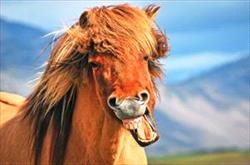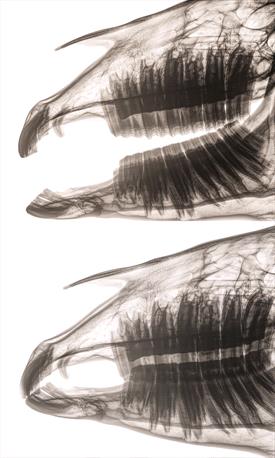Icelantic horse showing teeth

Never underestimate the old horse. His joints may be stiff, and his coat a bit rough. He may have lost or gained weight in odd places. But he knows things the fit youngsters don’t.
But like anything worth having, the old horse takes work and care.
What is “Old”?
When we ask if a horse, human, or hedgehog is old, we aren’t asking about how many times they’ve rotated around the sun. We really want to know how active, healthy, and alert the individual is. We want to know if they can perform their usual tasks or if they have special medical needs, and we want to know how much longer they will be a part of our lives.
Just like some humans run marathons well into “old” age and others retire much younger, some horses may be lame by ten years old while others are happily jumping fences or chasing cows well into their 20s or 30s.
In general, horses are considered geriatric (old), starting in their late teens to early 20s. However, nowadays, many horses live well into their 30s. This means our equine partners are with us much longer, but it also means they need more care for a longer time.
When it comes to horses living longer, two of the key advances in equine management have been dental care and the availability of senior feeds.
What Do You Need to Know About Your Horse’s Teeth?
Teeth come in two flavors: brachydont and hypsodont. Humans have brachydont teeth. Once our permanent teeth erupt, what is in our mouth is all there will be. Horses have hypsodont teeth. Their teeth don’t grow as they age, but they do continue a cycle of wear and eruption throughout the horse’s life.
If you think of teeth like icebergs and the gum as the waterline, humans have about as much iceberg below the waterline (roots) as we have above (tooth crown). Horses start with more iceberg below than above. The tooth lies mostly below the gum line and then slowly floats upward as the animal ages until it is all gone. As they age, the iceberg slowly erupts into the mouth and melts (wears down) as time goes on. By the time a horse is “long in the tooth”, there is, in reality, little tooth left.
This is where dental care comes in.
The answer to “Well, what happens to horses in the wild?” is simple. They die. They starve, colic, and/or are eaten by predators.
X-ray of horse head showing teeth

Side view of horse dental X-rays. The teeth in the middle to back of the mouth are the chewing/grinding teeth vs. teeth that cut through their food in the front of the mouth.
Grinders vs. Chompers
Ideally, to maximize tooth longevity, routine dental care should begin in early life and continue regularly. Unlike people, horses are grinders, not chompers. They don’t chew up and down but use a side-to-side-and-around, or elliptical (oval), motion.
This elliptical chewing, combined with the constant eruption of teeth, wears the horse’s teeth in particular patterns, often leaving high-and-low spots and sharp, jagged edges. Filing these edges and points regularly (floating) throughout the horse’s life helps maximize the chewing life of the teeth.
As your horse enters old age, saying “Ahhhhhh” for dental exams becomes even more important. Not only can regular dental care maximize comfort for your old horse, but a proper examination – by a veterinarian, under sedation, and with a full mouth speculum to hold the mouth open – can detect potential problems such as missing, loose, or infected teeth. These issues can make it harder for horses to properly chew hay or grass, leading to weight loss, choke (feed balling up and clogging the esophagus), and colic.
Even with regular care, you might notice signs of dental issues in your old horse between veterinary visits. Keep an eye out for weight loss; dropped clumps of poorly chewed hay or grass; long stems of hay or grass in the manure (yes, you should look at your horse’s poop every day; no, it’s not weird); goop from the nose or eye, especially on one side; or a nasty smell from the mouth or nose – horses shouldn’t have dragon breath. Any of these things could indicate a tooth, gum, or sinus problem.
Your horse’s head is mostly sinus – yes, they really are airheads – and there are a number of places where the molars extend up into the sinuses. An infected molar can yield a sinus infection.
Your equine veterinarian is a key part of a proper dental examination. While there are a number of non-veterinarian teeth floaters who have varying degrees of education about teeth, dental care - especially for an older horse - involves more body systems than just the teeth.
As your horse ages, you may notice the stray molar in the manger or hear your veterinarian utter the word “extraction” from time to time.
Why Bother With Dental Care?
Learning about hypsodont teeth may lead you to think, “If my horse’s teeth are going to fall out anyway, why should I pay to have you float them?”
The easy answer is you don’t want your horse to be in pain. You don’t want him to suffer infections. You don’t want to have to buy more expensive feed any longer than absolutely necessary.
Expensive feed, you say? Yes, this brings us to the “What happens when my horse runs out of teeth?” question.
Fortunately, when modern horses run out of tooth, they have options. There are a number of excellent, balanced senior feeds that are easy to chew or gum and digest. They can be used as a complete feed or to supplement hay or grass in horses that can still chew well. These feeds also help address the changing dietary needs of the older horse, who doesn’t need as much protein as a younger horse.
Your veterinarian may also refer you to an equine veterinary dental specialist to help your older horse have the best quality of life possible.